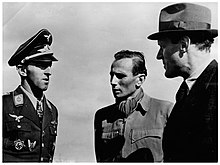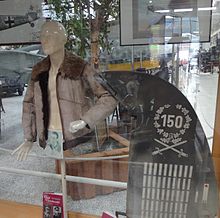Hermann Graf

Hermann Graf (born October 24, 1912 in Engen ; † November 4, 1988 there ) was a German fighter pilot . He served in the Air Force during World War II , most recently in the rank of colonel . In 830 sorties he shot down 212 enemy aircraft.
Live and act
youth
Hermann Anton Graf, who grew up unrefunded, was the son of the farmer Wilhelm Graf (1878–1937, artilleryman with the Iron Cross in World War I) and his wife Maria, née Sailer (1877–1953). After Wilhelm Wilhelm (1904–1981) and Josef Wilhelm (1909–1981) he was the last of the family's three children. After elementary school, he did an apprenticeship as a locksmith at a local factory from the age of 13 . He later became a land registrar.
In his youth he was an avid footballer. First he played for the local club DJK Engen, later he became a goalkeeper at FC Höhen. He was found to be good enough to participate with other young talents in training sessions with ex-national player Sepp Herberger , who later became world champion coach . A broken thumb put an end to his hopes for achievement as a footballer.
The gliding became his new hobby. After he had passed all glider pilot exams, he was drafted into the armed forces in 1939 .
Second World War
In April 1939 he took a non-commissioned officer course. In the spring of 1940 Graf was transferred to Jagdgeschwader 51 . During the war against France from May 10 to June 25, 1940, he flew 21 sorties without firing a single shot. In April 1941 he was in action over Greece and over Crete in the airborne battle for Crete and had not shot down an enemy aircraft in 50 missions. It was not until August 4, 1941, that he shot down an enemy aircraft near Kiev on the Eastern Front . After the number of his aerial victories rose rapidly as a result, he was promoted to lieutenant in the reserve in December 1941 and received the Luftwaffe's Cup of Honor. At the end of January 1942, Graf received the Knight's Cross of the Iron Cross for 45 kills . In March 1942 he became a squadron captain in Jagdgeschwader 52.
In May 1942 he was able to announce his 100th victory in the air and received the oak leaves for it, two days later he was awarded the swords. On September 9, 1942, Graf succeeded in shooting down the 172nd enemy aircraft, a mark not yet achieved at the time, which led to the award of the diamonds. This made him the fifth Wehrmacht soldier to receive this award. He was the first fighter pilot in the world to achieve 200 aerial victories when he shot down his 200th to 202nd opponent at the Battle of Stalingrad on September 26, 1942 over the Pitomnik airfield . He was then promoted to captain . In the German Reich he was particularly emphasized by the propaganda. Reports about Graf appeared in newspapers and magazines. He was sent on a lecture tour in the Reich. In 1942 Graf was named five times in the Wehrmacht report. These reports came on May 3rd, May 15th, September 5th, September 22nd and September 27th.
After a serious wound in a dogfight at the end of 1942, while he was recovering, he was appointed commander of the Fighter Pilot Supplementary Group East.
Squadron commodors
In March 1943 he set up the Jagdgeschwader 50 , which he led until September 1943. In September 1943 he moved to Jagdgeschwader 11 as a commodore . Here he scored ten confirmed kills against four-engined B-17 and B-24 bombers . On March 29, 1944, Graf shot down two heavy bombers, then was attacked by a P-51 . Running out of ammunition, he rammed the enemy machine, parachuted seriously injured and then spent six months in the hospital. This was his 212th victory in the air and also his last confirmed kill.
After further promotions, Graf became commodore of his Jagdgeschwader 52 at the end of September 1944 , most recently with the rank of colonel . In this function he took part in the so-called mutiny of the fighter pilots against Reichsmarschall Hermann Göring under the leadership of Colonel Günther Lützow in January 1945, which led to a dramatic discussion in the House of Fliers in Berlin with Göring on January 19, 1945. Although he was then banned from taking part in this (in Göring's eyes) mutiny , he continued to participate in skirmishes. The fact that he ignored this instruction was not reported, however, and therefore no recognized aerial victories were to be booked for him.
Football team "Rote Jäger"
Graf was an avid soccer player and founded a soccer team popular in the Third Reich , the " Rote Jäger ", for which well-known players such as Fritz Walter and Hermann Eppenhoff came to the respective location of his squadron, often on the recommendation of the later national coach Sepp Herberger , who in some cases also took the Trainers gave up, were assigned. His comrade Günther Rall writes in his memoir that Graf injured his jaw during a soccer game , which meant that he was often difficult to understand.
End of war

Towards the end of the war he marched west with his squadron. He was captured by American troops and extradited to the Soviet Union. In 1950 he was released from Soviet captivity .
While in captivity he distanced himself from the crimes of the Hitler regime and declared that the war had been a mistake because it had promoted the murders of the Einsatzgruppen of the Security Police and the SD . Because of these statements, it was later expelled from the comradeship association of fighter pilots .
Not connected to the usual rope teams, Graf found it difficult to establish himself in post-war Germany. At the request of Sepp Herberger, the Neuss-based entrepreneur Roland Endler - welding technology branch, later president of FC Bayern and in the 1960s organizer of the Brazilian world-class club around Pelé , FC Santos - hired the Graf, who had returned from prisoner-of-war warfare, as a salesman in his Stuttgart branch, where he ultimately rose to the ladder.
Graf was married three times and had a son and a daughter. In 1965 he was diagnosed with Parkinson's disease .
Awards
- Iron Cross (1939) 2nd class 1940
- Iron Cross (1939) 1st Class 1941
- Trophy of honor for special achievement in the aerial warfare on December 15, 1941
-
Knight's Cross of the Iron Cross with oak leaves, swords and diamonds
- Knight's Cross on January 24, 1942
- Oak leaves on May 17, 1942 (93rd award)
- Swords on May 19, 1942 (11th award)
- Diamonds on September 16, 1942 (5th award)
- German cross in gold on April 15, 1942
- Front flight clasp in gold
See also
- Air War in World War II
- List of German fighter pilots in World War II
- List of bearers of the Knight's Cross of the Iron Cross of Fighter Pilots
literature
- Dirk Bitzer, Bernd Wilting : Storming for Germany: The History of German Football from 1939 to 1954. Campus-Verlag, Frankfurt a. M. 2003, ISBN 3-593-37191-X , p. 152 ff.
- Black eagles, white eagles. German and Polish footballers at the wheel of politics ; Göttingen: The workshop, 2011; ISBN 978-3-89533-775-8 , pp. 40 f., 89 f.
- Heinrich Bücheler: Hermann Graf . In: Bernd Ottnad (Ed., On behalf of the Commission for Historical Regional Studies in Baden-Württemberg): Baden-Württembergische Biographien , Volume 2, Kohlhammer, Stuttgart 1999, ISBN 3-17-014117-1 , pp. 166–167.
- Ernst Obermaier, Die Ritterkreuzträger der Luftwaffe, Verlag Hoffmann, 1989, page 21, ISBN 3-87341-065-6 .
- BK Jochim, Oberst Herrmann Graf: 200 victories in 13 months, VPM Verlagsunion Pabel Moewig KG Rastatt, 1998, ISBN 3-8118-1455-9 .
Web links
- Hermann Graf at LeoBW.
Individual evidence
- ↑ Raymond F. Toliver, Trevor J. Constable: That was the German fighter pilot aces 1939-1945. Motorbuch Verlag, Stuttgart 1972, p. 288
- ↑ The Wehrmacht Reports. (Vol. III) GLB, Cologne 1989. ISBN 3-423-05944-3 .
- ↑ His name is not mentioned in the description of the events in Steinhoff's Last Hour , List 1974, p. 156, but in David Irving Göring , p. 667.
- ↑ Carles Viñas Gracia: Red Hunters: El victorioso equipo de fútbol de la Luftwaffe (III) , Blog de Carles Viñas, February 17, 2012.
- ↑ Christer Bergström, Vlad Antipov, Claes Sundin: Graf & Grislawski-A Pair of Aces , Eagle Editions Ltd., Hamilton MT, 2003. ISBN 0-9721060-4-9 . P. 269.
- ↑ Bergström, Christer; Antipov, Vlad; Sundin, Claes (2003). Graf & Grislawski — A Pair of Aces. Hamilton MT: Eagle Editions. P. 269 ff.
| personal data | |
|---|---|
| SURNAME | Graf, Hermann |
| BRIEF DESCRIPTION | German fighter pilot |
| DATE OF BIRTH | October 24, 1912 |
| PLACE OF BIRTH | Narrow |
| DATE OF DEATH | 4th November 1988 |
| Place of death | Narrow |
